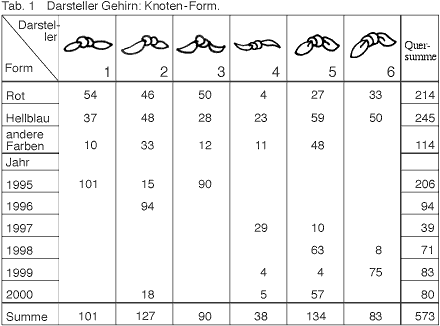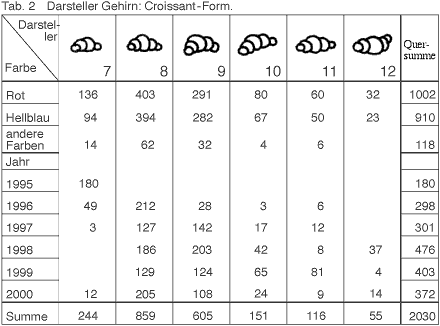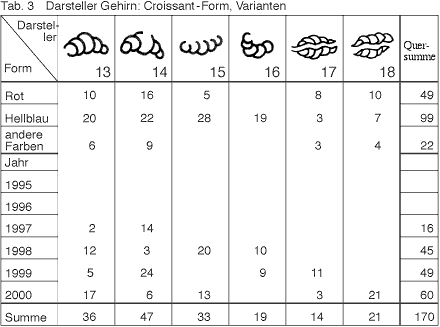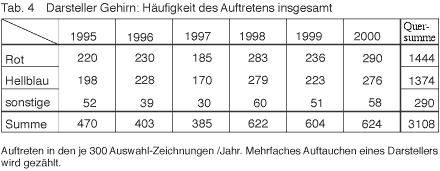| Drawing Generator |
| Development of the performers | |
| I will introduce here an investigation of the performer, "Brain", as an exemplary case of how a performer has developed and changed over the course of time since its first appearance, due to frequent usage i.e. intensive drawing and altered circumstances. [More on the current meaning of the performer, "Brain", here] |
|||||||||
|
|||||||||
| Although it is correct that each performer’s meaning will be determined by the context in which it appears, much can nevertheless be said about individual performers, when isolated from any association. |
|||||||||
 |
|||||||||
Judging by the material data, a change or reshaping from knot to croissant form can clearly be diagnosed in the case of the performer, Brain. The performer in Form 1, Tab.1, who after 1995 never appears again, was the basic form for brain, more accurately for "Small brain" until the year 1995. The performer’s shape was derived from the shape of a handkerchief knot: in the center, a two-part knot and two ends jutting out. In 1995, the new form for "Brain" appeared for the first time (Form 7, Tab.2): still comprised of 4 parts and recognizably derived from performer Form 1, Tab.1: the corners of the handkerchief knot have become round and are smaller through frequent drawing, but the basic structure of the performer has been retained. This form developed further and fast - the four-part form wasn’t good to draw, a center was missing, a highpoint, in order to draw the form right.......so forward to a five-part form for performer 8/Tab.2 , which since then has been the standard form for "Brain". Form 7 disappears in 1998 and 1999 only to reemerge in 2000 with an altered meaning; now this form stands for aged, conservative thinking. Or, less negatively, only for: "that’s the way we used to think". |
|||||||||
 |
|||||||||
The basic form as it now stands (Form 8, Tab.2) will be phased out in the coming years. Form 9 stands for beautiful thinking, Form 10 for stringent and progressive thinking. Performers 11 (see Tab. 2, in very straight order) and 12 (see Tab. 2, negatively bent) represent more negative aspects: Form 11 is for inflexible, unimaginary thinking and Form 12, for melancholy or also sluggish thinking. Similar to the four-part early form of the croissant for "Brain" (Form 7, Tab. 2), the knot form reappears in 1998 stronger than ever before, after nearly full disappearance. It made only a few appearances in 1997. The knot form has clearly developed: there are 2 additional lines, which emphasize the wrinkles of the knots (Form 5, Tab.1 - more on this form here). |
|||||||||
 |
|||||||||
And between the years 1998 and 1999, it changes once again: the knots’ endings tend to become wider, as wide as the knot itself (Form 6, Tab.1). In the following year, however, a regression happens. Kater seems to have thrown out Form 6. In 2000, it doesn’t appear at all. Asked about this development, Kater expressed himself doubtfully at first, then said that the gothic appearance of Form 6 had annoyed him. |
|||||||||
 |
|||||||||
On the subject of color distribution (see Tab.4), it could be said that the color red dominated - standing for active and positive content. The fact that the number of blue performers for "Brain" are not a lot fewer than red ones, can be explained by this performer also representing negative thoughts, wrong conclusions and unpleasant memories. |
|||||||||
 |
|||||||||
Additional earlier forms of the performer "Brain": the first 3 variants include the head seen from above where the brain is located (....the small protrusion below represents the nose tip). In Form 1, the cut open head reminds one of a bowl, the hinted at ears a handle....., Forms 2 and 3 also appear to represent listening in a better way: the ears as entrance to the brain. Forms 4 and 5 deal with variants of the so-called "Breadform" - brain. Nr. 4 is the earlier form of the performer "Breadbrain’ , which was the earlier ‘big brain’( more about the breadbrain performers here), developed from a view comparable to Forms Nr. 2 and Nr. 3, only that the representation of the head has been dropped in the course of time. |
|||||||||
| Form 5 appears seldom - and was originally derived from Form 4. The association, which led to the way it looks is from the Berlin saying: "dumb as bread.....and even dumber, dumb as a bread roll". |

 Top of the page
Top of the page